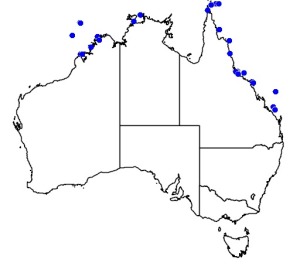�
�

©Anne Hoggett: A large free-living individual of Heliofungia actiniformis at Cobia Hole, Lizard Island.

©Anne Hoggett: Mouth of large free-living individual of Heliofungia actiniformis at Cobia Hole, Lizard Island.

©Anne Hoggett: A small individual of Heliofungia actiniformis still attached to the substrate at Cobia Hole, Lizard Island.
�
���
Heliofungia actiniformis

©Anne Hoggett: A large free-living individual of Heliofungia actiniformis at Cobia Hole, Lizard Island.

©Anne Hoggett: Mouth of large free-living individual of Heliofungia actiniformis at Cobia Hole, Lizard Island.

©Anne Hoggett: A small individual of Heliofungia actiniformis still attached to the substrate at Cobia Hole, Lizard Island.
Kingdom
Animalia
Phylum
Cnidaria
Class
Hexacorallia
Order
Scleractinia
Family
Fungiidae
Genus
Heliofungia
Species
Heliofungia actiniformis
Status
vulnerable
Colours
Distinguishing features
A fungid coral with large, bulb-tipped tentacles that are always extended. The oral disc is radially striped. Colour is typically light brown with pale tentacle tips. Septal teeth are well developed and triangular.
Size
- Up to 20 cm (diameter of specimens at Lizard Island)
Synonyms
Distribution
Distribution and habitat preferences
Sheltered back reef areas and lagoons.
Can be found in most habitats around Lizard Island.
Behaviour
H. actiniformis is a broadcast spawning hermaphrodite, however it can also brood larvae. In Sulawesi, the species reached 20cm diameter and an age of more than 20 years.
Web resources
References
- Baird, A.H., J.R. Guest and B.L. Willis (2009). Systematic and biogeographical patterns in the reproductive biology of scleractinian corals, Annual Review of Ecology, Evolution and Systematics, 40: 551-571.
- Knittweis, L., J. Jompa, C. Richter and M. Wolff (2009). Population dynamics of the mushroom coral Heliofungia actiniformis in the Spermonde Archipelago, South Sulawesi, Indonesia, Coral Reefs, 28: 793-804.
- Knittweis, L., W.E. Kraemer, J. Timm and M. Kochzius (2009). Genetic structure of Heliofungia actiniformis (Scleractinia: Fungiidae) populations in the Indo-Malay Archipelago: implications for live coral trade management efforts. Conservation Genetics, 10: 241-249.



